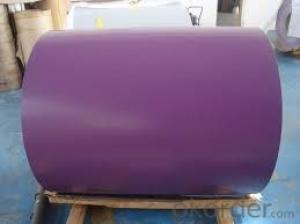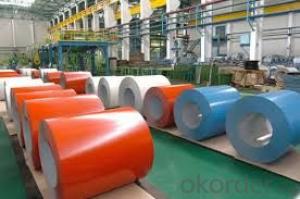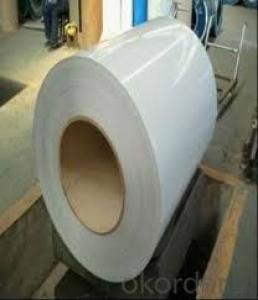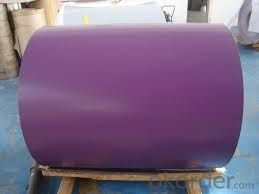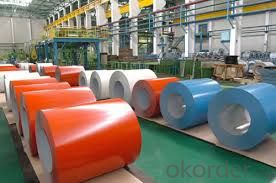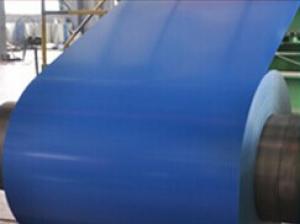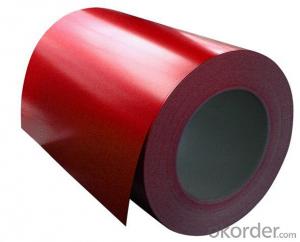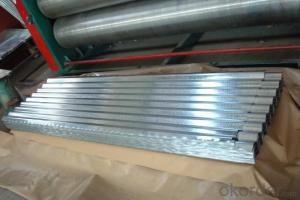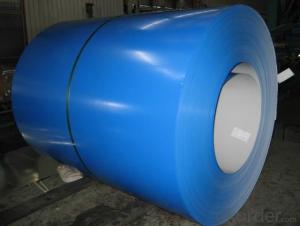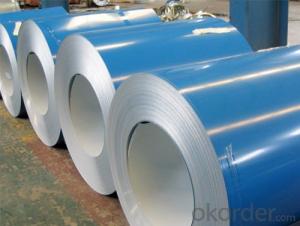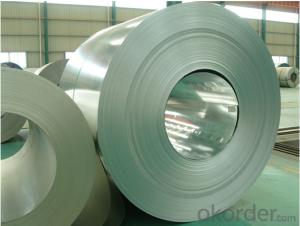Pre-Painted Color Coated Galvanized/Aluzinc Steel Coil
- Loading Port:
- Shanghai
- Payment Terms:
- TT OR LC
- Min Order Qty:
- 25 m.t.
- Supply Capability:
- 10000 m.t./month
OKorder Service Pledge
OKorder Financial Service
You Might Also Like
Product Description
PPGI and PPGL
0.14-3.0mm Special Color Galvanized / galvalume Steel Coil
1. Techinical standard: EN10169
2. Grade: TDX51D, SGCC
3. Thickness: 0.14-3.0mm (the most advantage thickness)
4. Width: 600-1250mm (610/724/820/914/1000/1200/1219/1220/1250)
5. Base metal: Galvanized / galvalume steel
6. Finish Painting: 15-20miu PE on top
Back painting: 5-8miu PE on back
7. Type of PPGI and PPGL with pattern
Specifications:
1. Standard: AISI, ASTM, BS, DIN, GB, JIS, ASTM, JIS, GB
2. Steel Grade: DX51D, SGCC, SGCH, SPCC, SPCD, DC01, ST12, ST13, Q195, 08AL
3. Thickness: 0.14-3.0mm
4. Width: 600-1250mm
5. Length: Up to The Thickness or as require
6. Spangle: Zero, Mini, Regular, Big, Skin Pass
7. Audited Certificates: BV, SGS, ISO, CIQ
8. Zinc Coating: 40g-275g or AZ 40-150g
9. Surface: Chromated, dry/oiled, Cr3 treated anti-finger
10. Package: Standard exporting package (or as required)
Why Us:
1, Mill/factory supply, Quality protection, 4 Galvanized steel lines keep runing.
2, Competitive price with best quality and service
3, Nearest sea port, Convenient transportation, Efficient service team online for 24 hours
4, More than 7 years Export Experiences, More than 50 countries customers
5. Delivery time: Within 25-35 days after the receipt of L/C or according to customer's requirement.
Warranty:
As the professional manufacturer and supplier of the steel, CNBM steel corporation makes the steel co-operation mutual beneficial without any risky to the worldwide customers. CNBM Steel sales&service department not only promise to provide the high quality products, excellent communication, fast and reliable deliveries, as well as the reasonble price, but also help the customers to develop the market better with more efforts.
World wide customer satisfaction:
More than 50 worldwide customers none-risky experiences approved.
CNBM Steel has been exporting steel coils to more than 50 countries directly. Our long term supply extends to USA, UK, Germany, Italy, Spain, Belgium, France, Poland, Greece, Ukraine, Belarus, Russia, Turkey, Egypt, Saudi Arabia, Iran, Ethiopia, Niger, Brazil, Colombia, Chile, Peru, Australia, New Zealand, etc...
commodityColor-coated Roofing Galvanized Steel sheet
Techinical Standard: JIS G3302-1998, EN10142/10137, EN 10169
gradeSGCC, DX51D / DX52D / S250, 280GD
Types: For general / drawing use
Thickness0.14-3.0mm
Zinc Coating: 40g-275g or AZ 40-150g
Spanglet:No/ small/ big regular
Surface treament:Chromed passivation, anti-finger print, skinpassed
Sheet weight:3-5MT
Profile model: YX14-65-825/ YX18-76.2-836 / YX14-63.5-825 /
YX35-125-750 / YX15-225-900 / YX10-125-875 /
YX12-110-880 / YX25-210-840 / YX25-205-820(1025)
Package: Properly packed for ocean freight exportation in 20' ' containers
Application:Roof, walls, internal and external decorating materials, building etc
Price termsFOB, CFR, CIF
Payment terms20%TT in advance+80% TT or irrevocable 80%L/C at sight
delivery time25 days after recepit of 20% TT
RemarksInsurance is all risks
MTC 3.1 will be handed on with shipping documents
We accept SGS certificatation test
Contact Information, Samson, TEL:86-021-51683864 FAX: 86-021-51683454
Phone: 0086-13671603878
commodity | Brick pattern Color Galvanized Steel Sheet (PPGI/ PPGL) |
Techinical Standard: | JIS G3312-1998, EN101169, ASTM A755 |
grade | TSGCC, TDX51D / TDX52D / TS250, 280GD |
Types: | For general / drawing use |
Base metal | galvanized, galvalume |
Thickness | 0.14-3.0mm(0.16-0.8mm is the most advantage thickness) |
Width | 610/724/820/914/1000/1200/1219/1220/1250mm |
Type of coating: | PE, SMP, PVDF |
Zinc coating | Z60-275g/m2 or AZ40-150g/m2 |
Top painting: | 5 mic. Primer + 15 mc. R. M. P. |
Back painting: | 5-7 mic. EP |
Color: | According to RAL standard |
ID coil | 508mm / 610mm |
Coil weight: | 4--8MT |
Package: | Properly packed for ocean freight exportation in 20' ' containers |
Application: | Industrial panels, roofing and siding for painting / automobile |
Price terms | FOB, CFR, CIF |
Payment terms | 20%TT in advance+80% TT or irrevocable 80%L/C at sight |
delivery time | 25 days after recepit of 20% TT |
Remarks | Insurance is all risks |
MTC 3.1 will be handed on with shipping documents | |
We accept SGS certificatation test |
- Q: How are steel coils inspected for surface finish?
- Steel coils are inspected for surface finish through a visual examination by trained inspectors. They carefully inspect the coils for any defects, such as scratches, pits, or uneven surfaces. Additionally, specialized equipment like optical scanners or digital cameras may be used to capture high-resolution images for a more detailed analysis. The goal is to ensure that the surface finish of the steel coils meets the required standards and is free from any imperfections that could affect its quality or performance.
- Q: What are the different coil packaging methods used for steel coils?
- There are several coil packaging methods that are commonly used for steel coils. These methods are designed to ensure the protection and safe transportation of steel coils, as well as to optimize storage space. Some of the different coil packaging methods used for steel coils include: 1. Strapping: This method involves securing the steel coils with metal or plastic straps. Strapping provides stability and prevents the coils from unrolling or shifting during transportation. It is commonly used for smaller coils or when additional packaging methods are also employed. 2. Stretch wrapping: Stretch wrapping involves using a stretch film to tightly wrap the steel coils. This method provides excellent protection against dust, moisture, and other contaminants. It also helps to keep the coils tightly bound together and prevents them from moving during handling and transportation. 3. Steel banding: Steel banding is a method that involves using steel bands or straps to secure the coils. This packaging method provides superior strength and durability. Steel banding is commonly used for larger and heavier steel coils that require extra reinforcement. 4. Wooden crating: Wooden crates are often used for packaging steel coils that are particularly large or heavy. The coils are placed within a wooden crate, which provides enhanced protection against impacts, moisture, and other external factors. Wooden crating is typically utilized for long-distance transportation or for coils that need to be stored for extended periods. 5. Coil saddles: Coil saddles are specialized devices that are used to package steel coils. These devices are designed to securely hold the coils in place and prevent them from rolling or moving. Coil saddles are commonly used for large coils that cannot be easily strapped or wrapped. 6. Paper interleaving: Paper interleaving involves placing sheets of paper between each layer of steel coils. This method helps to prevent damage caused by friction between the coils. Paper interleaving is often used for coils that have a high surface finish or are susceptible to scratching. Each of these coil packaging methods offers distinct advantages and is chosen based on factors such as the size and weight of the steel coils, transportation requirements, and the desired level of protection. By employing these packaging methods, steel coil manufacturers and distributors can ensure that their products arrive safely and in optimal condition at their destination.
- Q: What are the safety regulations for handling steel coils?
- The safety regulations for handling steel coils include wearing appropriate personal protective equipment, such as gloves and steel-toed boots, using proper lifting techniques and equipment, ensuring a clear and organized work area, and following guidelines for stacking and securing coils to prevent accidents and injuries. Regular inspections and maintenance of equipment and storage areas are also crucial for ensuring safe handling of steel coils.
- Q: What are the different types of surface treatments for steel coils?
- There are several different types of surface treatments available for steel coils, each designed to enhance the appearance, protect against corrosion, and improve the overall durability of the steel. Some of the commonly used surface treatments for steel coils include: 1. Hot-dip galvanizing: This process involves immersing the steel coils in a bath of molten zinc, which forms a protective layer on the surface. Hot-dip galvanizing provides excellent corrosion resistance and can withstand harsh environments. 2. Electro-galvanizing: In this method, a thin layer of zinc is electroplated onto the surface of the steel coils. Electro-galvanizing offers good corrosion resistance and improves the aesthetics of the steel. 3. Organic coating: Steel coils can be coated with organic materials such as paints, lacquers, or polymer films. These coatings provide protection against corrosion, abrasion, and UV radiation, while also offering a wide range of color options. 4. Phosphating: Phosphating is a chemical treatment that converts the steel surface into a layer of phosphate crystals. This treatment enhances the adhesion of subsequent coatings and improves the corrosion resistance of the steel. 5. Chromating: Also known as passivation, chromating involves the application of a chromate conversion coating onto the steel surface. This treatment enhances the corrosion resistance and provides a decorative finish. 6. Oiling: Oiling is a simple surface treatment that involves applying a thin layer of oil onto the steel coils. This treatment helps prevent corrosion during storage and transportation and can be easily removed before further processing. 7. Pickling: Pickling is a process where the steel coils are immersed in an acid solution to remove impurities and scale from the surface. This treatment improves the surface finish and prepares the steel for subsequent processing or coatings. 8. Tin plating: Steel coils can be coated with a layer of tin through electroplating. Tin plating provides excellent corrosion resistance, solderability, and aesthetic appeal. These are just a few of the many surface treatments available for steel coils. The choice of treatment depends on the specific requirements of the application, including the desired appearance, corrosion resistance, and environmental conditions the steel will be exposed to.
- Q: what is the difference between stainless steel 304 (AISI 304) and stainless steel 310 (AISI 310) COR-TEN A
- Weathering steel will rust, but the rust will be adherant and not flake off and be replaced by new rust. Therefore once it rusts it will pretty much stop rusting any more. One (severe) down side is that anything around it will be streaked with rust stains and it will look awful. Some bozo with the Texas Department of Transportation designed a number of freeway interchange overpasses here in Houston using Cor-Ten steel and all of the concrete supports are streaked with red rust stains and it looks like hell. Cameron built an office building here in Houston with a Cor-Ten facade and it is streaked with rust too. They should have gone ahead and spent the money and painted them, but they didn't.
- Q: I have a Victorinox Pioneer, and I recently filed a little metal off the blade for some jimping. Is the already stainless steel blade still stainless?
- Stainless steel knives, sinks, etc.may or may not be stainless steel all the way through. The question arises however, what Quality of stainless steel? For steel to be highly rust resistant, a minimum of 12% chromium must be added to the iron along with carbon (for hardness). Good food-grade stainless also is likely to contain nickel, niobium, molybdenum, and/or titanium. Victorinox has a pretty good reputation to protect so I would expect your blade is still stainless. Some good old American brand names however have been sold to marketers who outsource manufacturing to China and scrimp on the chromium and nickle content in their stainless products. That is why you can spend $50 at Lowes for a stainless steel barbeque tool set of fork, tongs, lifter etc and find them spotted with rust within a few months.
- Q: What are the environmental impacts of steel coil production?
- The environmental impacts of steel coil production include the extraction of raw materials, such as iron ore and coal, which can lead to deforestation, habitat destruction, and soil erosion. The steel manufacturing process also releases significant amounts of greenhouse gases, such as carbon dioxide, contributing to climate change. Additionally, the production of steel coils requires large amounts of water and energy, leading to water scarcity and increased carbon emissions.
- Q: I just bought a dpms ar15 and it says if I shoot steel cases (laquer coated) or foreign ammo it voids the warranty. But before I knew this I bought 200 rounds of Russian steel cased anmo. Think I should just shoot there two hundred and not buy anymore? Some people say all they shoot is steel cased ammo and have no problemAny advice is appreciated
- Steel Case Ammo
- Q: What are the different types of steel coil slitting knives?
- There are several different types of steel coil slitting knives, including circular slitting knives, straight slitting knives, and crush-cut slitting knives. These knives are used for precision cutting and slitting of steel coils into narrower strips or sheets. Circular slitting knives feature a circular shape with sharp edges, while straight slitting knives have a straight cutting edge. Crush-cut slitting knives have a unique design that allows them to crush and cut the material simultaneously. Each type of knife is used for specific applications and offers different advantages depending on the desired outcome.
- Q: How are steel coils used in the manufacturing of railway wagons?
- Steel coils are used in the manufacturing of railway wagons as they serve as a raw material for various components such as the wagon body, chassis, and structural parts. These coils are processed, cut, and shaped to form the required parts, ensuring the wagon's strength, durability, and load-bearing capacity. The steel coils are transformed into sheets, plates, or beams, which are then welded, bolted, or riveted together to construct the wagon's framework and body. Overall, steel coils play a vital role in providing the necessary strength and structural integrity to railway wagons.
Send your message to us
Pre-Painted Color Coated Galvanized/Aluzinc Steel Coil
- Loading Port:
- Shanghai
- Payment Terms:
- TT OR LC
- Min Order Qty:
- 25 m.t.
- Supply Capability:
- 10000 m.t./month
OKorder Service Pledge
OKorder Financial Service
Similar products
Hot products
Hot Searches
Related keywords
